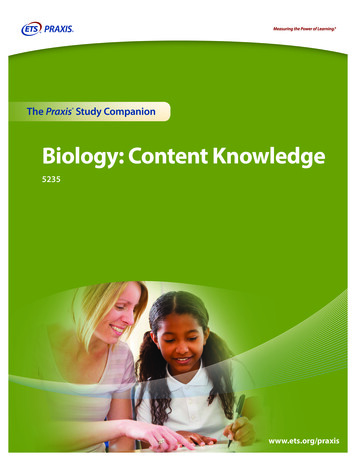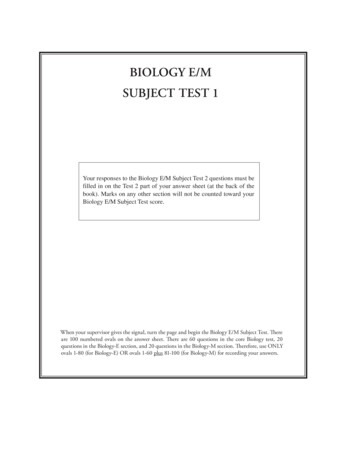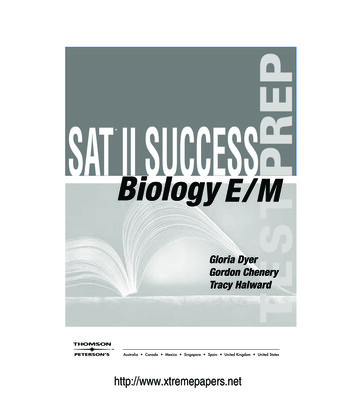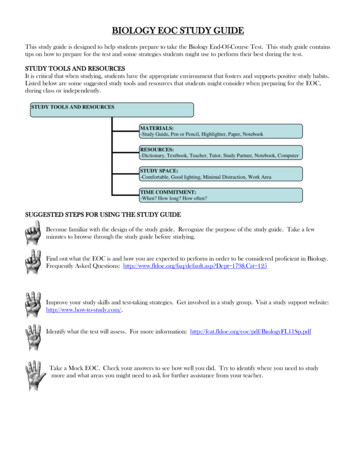
Transcription
The Praxis Study CompanionBiology: Content Knowledge5235www.ets.org/praxis
Welcome to The Praxis Study CompanionWelcome to The Praxis Study CompanionPrepare to Show What You KnowYou have been working to acquire the knowledge and skills you need for your teaching career. Now you areready to demonstrate your abilities by taking a Praxis test.Using the Praxis Study Companion is a smart way to prepare for the test so you can do your best on test day.This guide can help keep you on track and make the most efficient use of your study time.The Study Companion contains practical information and helpful tools, including: An overview of the Praxis tests Specific information on the Praxis test you are taking A template study plan Study topics Practice questions and explanations of correct answers Test-taking tips and strategies Frequently asked questions Links to more detailed informationSo where should you start? Begin by reviewing this guide in its entirety and note those sections that you needto revisit. Then you can create your own personalized study plan and schedule based on your individual needsand how much time you have before test day.Keep in mind that study habits are individual. There are many different ways to successfully prepare for yourtest. Some people study better on their own, while others prefer a group dynamic. You may have more energyearly in the day, but another test taker may concentrate better in the evening. So use this guide to develop theapproach that works best for you.Your teaching career begins with preparation. Good luck!Know What to ExpectWhich tests should I take?Each state or agency that uses the Praxis tests sets its own requirements for which test or tests you must take forthe teaching area you wish to pursue.Before you register for a test, confirm your state or agency’s testing requirements at www.ets.org/praxis/states.How are the Praxis tests given?Praxis tests are given on computer. Other formats are available for test takers approved for accommodations (seepage 48).The Praxis Study Companion2
Welcome to The Praxis Study CompanionWhat should I expect when taking the test on computer?When taking the test on computer, you can expect to be asked to provide proper identification at the testcenter. Once admitted, you will be given the opportunity to learn how the computer interface works (how toanswer questions, how to skip questions, how to go back to questions you skipped, etc.) before the testing timebegins. Watch the What to Expect on Test Day video to see what the experience is like.Where and when are the Praxis tests offered?You can select the test center that is most convenient for you. The Praxis tests are administered through aninternational network of test centers, which includes Prometric Testing Centers, some universities, and otherlocations throughout the world.Testing schedules may differ, so see the Praxis web site for more detailed test registration information at www.ets.org/praxis/register.The Praxis Study Companion3
Table of ContentsTable of ContentsThe Praxis Study Companion guides you through the steps to success1. Learn About Your Test.5Learn about the specific test you will be taking2. F amiliarize Yourself with Test Questions. 12Become comfortable with the types of questions you’ll find on the Praxis tests3. Practice with Sample Test Questions. 16Answer practice questions and find explanations for correct answers4. Determine Your Strategy for Success. 28Set clear goals and deadlines so your test preparation is focused and efficient5. Develop Your Study Plan. 31Develop a personalized study plan and schedule6. Review Study Topics. 35Detailed study topics with questions for discussion7. Review Smart Tips for Success. 46Follow test-taking tips developed by experts8. Check on Testing Accommodations. 48See if you qualify for accommodations to take the Praxis test9. Do Your Best on Test Day. 49Get ready for test day so you will be calm and confident10. Understand Your Scores. 51Understand how tests are scored and how to interpret your test scoresAppendix: Other Questions You May Have . 53The Praxis Study Companion4
Step 1: Learn About Your Test1. Learn About Your TestLearn about the specific test you will be takingBiology: Content Knowledge (5235)Test at a GlanceTest NameBiology: Content KnowledgeTest Code5235Time2.5 hoursNumber of Questions150FormatSelected-response questionsTest DeliveryComputer deliveredContent CategoriesApproximateNumber ofQuestionsApproximatePercentage ofExaminationNature of Science: Scientific Inquiry,Methodology, Techniques, and History2114%Molecular and Cellular Biology3020%III. Genetics and Evolution3020%IV. Diversity of Life and Organismal Biology3020%V.2416%1510%I.VIIVIVIIIIIII.Ecology: Organisms and EnvironmentsVI. Science, Technology, and Social PerspectivesAbout This TestThe Biology: Content Knowledge test is designed to measure the knowledge and competencies necessary fora beginning teacher of secondary school Biology. Examinees have typically completed or nearly completed abachelor’s degree program with appropriate coursework in Biology and education.The development of the test questions and the construction of the test reflect the National Science EducationStandards (NSES) and the National Science Teacher Association (NSTA) standards and recognize that thereare conceptual and procedural schemes that unify the various scientific disciplines. These fundamentalconcepts and processes (systems; models; constancy and change; equilibrium; form and function) are useful inunderstanding the natural world. Insofar as possible, then, the test questions will have the primary objective ofevaluating the content areas by using questions that focus on conceptual understanding, critical thinking, andproblem solving in science. The test content is developed and reviewed in collaboration with practicing highschool Biology teachers, teacher-educators, and higher education content specialists to keep the test updatedand representative of current standards.The 150 selected-response questions include concepts, terms, phenomena, methods, applications, data analysis,and problem solving in Biology, and include an understanding of the impact of science and technology on theenvironment and human affairs. The topics are typically those covered in introductory college-level Biologycourses, although some questions of a more advanced nature are included, because secondary-school teachersmust understand the subject matter from a more advanced viewpoint than that presented to their students.The Praxis Study Companion5
Step 1: Learn About Your TestExaminees will not need to use calculators in takingthis test.E.1.2.3.4.5.This test may contain some questions that will notcount toward your score.Test SpecificationsTest specifications describe the knowledge andskills measured by the test. Study topics to help youprepare to answer test questions can be found onpage 35.I.Nature of Science: Scientific Inquiry,Methodology, Techniques, and HistoryA.1.2.3.4.5.B.Processes Involved in Scientific InquiryD.G.H.1.2.3.4.Differences among Facts, Hypotheses,Theories, and LawsI.The Praxis Study CompanionConstruct and Use Scientific Models toExplain Complex PhenomenaProcedures Involved in the SafePreparation, Storage, Use, and Disposalof Laboratory and Field MaterialsMolarity and percent solutionsAcid and base solutionsFlammable and/or caustic materialsBiological specimens and wasteAppropriate and Safe Use and Care ofLaboratory Equipment1. Optical equipment (e.g., microscopes,spectrophotometers, UV light sources)2. Separation equipment (e.g., gelelectrophoresis, chromatography, centrifuges)3. Measurement, mixing, and heating equipment(e.g., balances, stirrers, burners)4. Sterilization equipment (e.g., autoclave, ovens)Scientific Ideas Change over Time;Contributions Made by Major HistoricalFigures1. Cell theory and germ theory (e.g., Hooke,Pasteur)2. Heredity, evolution, and ecology (e.g., Mendel,Darwin)3. Structure and nature of genetic material (e.g.,Hershey and Chase, Franklin, Watson and Crick)4. Classification of organisms (e.g., Linnaeus,Woese)Identify patterns and trends in dataChoose appropriate types of graphs or chartsError analysisDraw conclusions and make predictions1. Limitations of models2. Select models for a given purpose3. Physical (e.g., anatomical models), conceptual(e.g., fluid mosaic model), graphical and/ormathematical models (e.g., population growthor climate change models)Science Involves Many Disciplines1. Testable nature of hypotheses2. Formulation of theories based on accumulateddata3. Durability of lawsPrecision versus accuracyMetric and SI unitsUnit conversionsScientific notation and significant figuresLinear versus logarithmic scales (e.g., pH)Read and Interpret Data Represented inTables, Graphs, and Charts1.2.3.4.Making observationsFormulating and testing hypothesesIdentifying experimental variables and controlsConclusions: proof versus supportScientific sources and communicating findings1. Chemical nature of biology2. Calculations in biology (e.g., statistics,probability)3. Physical laws and principles governingbiological systemsC.F.Appropriate Use of ScientificMeasurement and Notation SystemsJ.Safety and Emergency Procedures forScience Classrooms and Laboratories1. Use of material safety data sheets (MSDS, orsafety data sheets, SDS)2. Use of personal safety equipment: (e.g., gloves,goggles, lab coats)3. Use of laboratory safety equipment (e.g., fireextinguishers, eye wash stations, emergencyshowers)6
Step 1: Learn About Your TestII.Molecular and Cellular BiologyA.Chemical Structures and Properties ofBiologically Important Molecules1.2.3.4.5.Atomic structureOrganic versus inorganic moleculesChemical bonding (e.g., hydrogen, covalent)Molecular structure (e.g., water, oxygen)Water properties (e.g., cohesion, high specificheat)6. Macromolecules (e.g., carbohydrates, nucleicacids, proteins, lipids)B.D.1.2.3.4.Major Differences between Prokaryotesand EukaryotesCell sizeMembrane-bound organellesCell walls (e.g., peptidoglycan, cellulose)Chromosome structure (e.g., circular versuslinear)The Praxis Study CompanionCells Maintain their Internal Environmentand Respond to External Signals1. Selective permeability2. Active and passive transport3. Water movement (e.g., osmolarity, waterpotential)4. Cell surface proteins and cell communication5. Exocytosis and endocytosis6. Hormone action and feedbackH.Cellular Division, the Cell Cycle, and HowThey Are Regulated1. Cell cycle stages ( G1, S, G2, M )2. Mitosis and meiosis (e.g., stages, functions,results)3. Cytokinesis (e.g., cleavage furrow, cell plate)4. Cell cycle checkpointsI.Structure and Function of Nucleic Acids1.2.3.4.Sugar-phosphate backboneDNA versus RNAComplementary base pairingChromosome structure (e.g., nucleosomes,telomeres, linear versus circular)5. DNA replicationBiochemical Pathways and Energy FlowWithin an Organism1. Cellular locations of biochemical pathways2. Photosynthesis (e.g., photosystems, electrontransport, C3 and C4 )3. Cellular respiration (e.g., fermentation, Krebs(citric acid) cycle, electron transport chain)4. Chemosynthesis (e.g., deep sea ventmicroorganisms)E.G.Structure and Function of Enzymes andFactors Influencing their Activity1. Active site structure and substrate binding(e.g., induced fit, lock and key)2. Reaction kinetics (e.g., effects of temperature,pH, and inhibitors)3. Regulation (e.g., cooperative binding, feedbackinhibition)Structure and Function of Cells andOrganelles1. Plant cells versus animal cells2. Cell membranes3. Membrane-bound organelles (e.g., nucleus,chloroplast) and ribosomes4. CytoskeletonBiological Processes Are Dependent onChemical Principles1. Chemical and physical gradients (e.g., osmosis,diffusion, temperature)2. Thermodynamics3. Anabolic and catabolic reactions (e.g.,hydrolysis)4. Reduction-oxidation reactionsC.F.J.Processes Involved in Protein Synthesis1. RNA transcription2. mRNA processing (e.g., polyadenylation,splicing)3. Translation (e.g., ribosome structure, tRNA)K.1.2.3.4.5.Regulation of Gene ExpressionPromotersEnhancersTranscription factorsOperonsEnvironmental influences (e.g., epigenetics)7
Step 1: Learn About Your TestL.Cells May Undergo Differentiation andSpecializationC.1. Differential gene expression2. Stem cells (e.g., sources, developmentalpotential)M.N.O.Use and Applications of DNATechnologies and Genetic Engineering1. DNA sequencing and polymerase chainreaction (PCR)2. Genome sequencing projects (e.g., HumanGenome Project)3. Gene therapy4. Cloning5. Transgenic and genetically engineered cellsGenetics and EvolutionA.1.2.3.4.B.D.Mendel’s Laws and Predicting theProbable Outcome of Given GeneticCrossesIndependent assortmentLaw of segregationMonohybrid and dihybrid crossesPedigree analysisNon-Mendelian inheritance1. Linkage (e.g., recombination mapping)2. Sex-linked inheritance3. Multiple alleles, codominance, and incompletedominance4. Polygenic inheritance, epistasis, and pleiotropy5. Organelle inheritance (e.g., mitochondrialinheritance)The Praxis Study CompanionSources of Genetic Variation1. Mutation2. Crossing-over3. Genetic exchange (e.g., transduction,transformation, conjugation)4. Sexual reproduction (e.g., independentassortment)Use of Basic Laboratory Techniques toStudy Biological Processes1. Gel electrophoresis2. Microscopy3. SpectrophotometryIII.1. Changes in chromosome numbers (e.g., Downsyndrome)2. Changes in chromosome structure (e.g.,deletion, inversion, duplication, translocation)3. Common genetic disorders (e.g., Sickle-cellanemia, Tay-Sachs disease)Nature of Mutations1. Causes of mutations (e.g., recombination,mutagens)2. Types of mutations (e.g., point mutation,deletion, inversion, translocation)3. Somatic versus germline mutationsChromosomal and Genetic Changes thatLead to Common Human GeneticDisordersE.Mutations, Gene Flow, Genetic Drift, andNonrandom Mating Affect the Gene Poolof a Population1. Distribution and movement of alleles withinpopulations2. Distribution and movement of alleles betweenpopulationsF.Principles and Applications of HardyWeinberg Equilibrium1. Conditions of HW equilibrium2. Calculating allele frequencies using the HWequationG.1.2.3.4.5.H.Mechanisms of EvolutionNatural and artificial selectionSexual selectionGenetic drift (e.g., bottleneck, founder effect)CoevolutionAdaptive radiationEvidence that Supports Evolution1. Molecular evidence (e.g., DNA sequencecomparisons)2. Structural and developmental evidence (e.g.,homology, embryology)3. Fossil record4. Endosymbiosis5. Convergent versus divergent evolution6. Major evolutionary trends (e.g., cephalization,multicellularity)8
Step 1: Learn About Your TestI.Genetic Basis of SpeciationD.1. Reproductive isolation (e.g., prezygotic,postzygotic)2. Types of speciation (e.g., allopatric, sympatric)J.1. Body plans (e.g., radial versus bilateralsymmetry)2. Body cavities (e.g., coelomates,pseudocoelomates, acoelomates)3. Modes of reproduction4. Modes of temperature regulation (e.g.,endotherm, ectotherm)Models of Evolutionary Rates1. Gradualism2. Punctuated equilibriumK.Scientific Explanations for the Origin ofLife on Earth1. Panspermia (e.g., asteroid seeding)2. Abiotic synthesis of organic compounds (e.g.,Miller-Urey experiment)3. Biological influences on atmosphericcomposition (e.g., photosynthesis)4. Development of self-replication (e.g., RNAworld)L.E.1.2.3.4.F.G.1.2.3.4.B.Characteristics of Living Versus NonlivingThingsCellular organizationGrowth and reproductionRegulation and responses to the environmentObtain and use energyH.Historical and Current BiologicalClassification Systems of Organisms1.2.3.4.1. Kingdom system2. Domain systemC.Defining Characteristics of Viruses,Bacteria, Protists, Fungi, Plants, andAnimals1. Structure (e.g., capsid, cell wall, organelles)2. Organization (e.g., prokaryote, multicellular)3. Modes of nutrition (e.g., heterotroph,autotroph)4. Reproduction/replication (e.g., viral replication,binary fission, budding)The Praxis Study CompanionCellsTissuesOrgansOrgan systemsCardiovascular and respiratoryReproductiveDigestive and excretoryNervous and endocrineImmuneMaintenance of Homeostasis inOrganisms1. Role of structural components (e.g., kidney,hypothalamus)2. Feedback mechanisms3. Role of hormones (e.g., antidiuretic hormone(ADH), insulin)4. Role of behaviors (e.g., diurnal, nocturnal,basking)IV. Diversity of Life and Organismal BiologyA.Organizational Hierarchy of MulticellularOrganismsAnatomy and Physiology of Major OrganSystems in Animals1.2.3.4.5.Factors that Lead to Extinction ofSpecies1. Lack of genetic diversity2. Environmental pressures (e.g., climate andhabitat change)3. Human impacts4. Interspecific competitionCharacteristics of the Major Animal PhylaI.Reproduction, Development, and Growthin AnimalsGamete formationFertilizationEmbryonic developmentGrowth, development, and agingCharacteristics of Major Plant Divisions1. Vascular versus nonvascular plants2. Flowering versus nonflowering plants3. Monocot versus eudicot (dicot)9
Step 1: Learn About Your TestJ.Structure and Function of Major PlantTissues and Organs1.2.3.4.5.K.DermalVascular (i.e., xylem, phloem)Ground (e.g., parenchyma, cortex)MeristemsFlowers, stems, leaves, and rootsD.1. Sexual versus asexual reproduction2. Parental investment3. Number of offspring produced versus numberthat surviveE.Plant Life Cycles and ReproductiveStrategiesPlants Obtain and Transport Water andInorganic NutrientsF.Plants Transport and Store Products ofPhotosynthesis1. Products (e.g., simple and complexcarbohydrates)2. Phloem transport3. Storage and support molecules (e.g., starch,cellulose)4. Storage structures (e.g., plastids, vacuoles,tuber)V.G.1.2.3.4.H.B.Biotic and Abiotic Components of anEcosystem Influence Population Size1. Resource availability and abiotic factors (e.g.,nutrients and temperature)2. Habitat and niche3. Competition and predationC.Models of Population Growth1. Exponential growth2. Logistic growth (e.g., carrying capacity)The Praxis Study CompanionEnergy Flow in the Environment1. Trophic levels (e.g., pyramids of biomass,pyramids of energy)2. Food websI.Biogeochemical Cycles1.2.3.4.Hierarchical Structure of the es and Characteristics of Biomes1. Aquatic (e.g., stream, estuary, coral reef )2. Terrestrial (e.g., desert, grassland, tropical rainforest)Ecology: Organisms and EnvironmentsA.Changes Occur During EcologicalSuccession1. Primary versus secondary succession2. Biomass, diversity, productivity, and habitatchanges during succession1. Roots2. Xylem transport3. Control (e.g., stomata)M.Relationships Within and BetweenSpecies1. Symbiosis (e.g., parasitism, commensalism,mutualism)2. Predation3. Competition and territoriality4. Altruistic behaviors1. Alternation of generations (i.e., gametophyte,sporophyte)2. Pollination strategies (e.g., wind, insect)3. Seed dispersalL.Relationship Between ReproductiveStrategies and Mortality RatesJ.Water cycleCarbon cycleNitrogen cyclePhosphorus cycleEffects of Natural Disturbances onEcosystems1. Temporal and spatial disturbances (e.g.,climate, fire, disease)2. Fragmentation of ecosystems3. Natural ecosystem recoveryK.Humans Affect Ecological Systems andBiodiversity1. Pollution (e.g., greenhouse gases, acidprecipitation)2. Habitat destruction (e.g., deforestation)3. Introduced species (e.g., non-native,reintroduced)4. Remediation (e.g., reforestation, minereclamation)10
Step 1: Learn About Your TestL.Connections among Ecosystems on aLocal and Global Scale1. Natural flow of material between ecosystems2. Transport of materials by humans3. Movement of organisms (e.g., migration)VI. Science, Technology, and SocialPerspectivesA.Impact of Science and Technology on theEnvironmentD.Ethical and Societal Issues Arising fromthe Use of Science and Technology1. Ethical research concerns (e.g., stem cells, toxicchemicals)2. Ethical use of technology (e.g., geneticallymodified organisms, cloning)3. Societal concerns (e.g., security of geneticinformation, equal access to medicaltreatment)1. Pollution and pollution mitigation (e.g.,burning fossil fuels, green building,environmental cleanup)2. Resource management (e.g., wastemanagement, recycling, efficiency)3. Conservation (e.g., habitat protection, habitatrestoration, species protection)4. Non-point sources of pollution (e.g., lawnfertilizers)B.Impact of Human Activity and NaturalPhenomena on Society1. Consequences (e.g., economic, social)2. Disaster management (e.g., hurricane relief andcleanup)3. Global warming, sea levels, flooding4. Epidemiology (e.g., malaria, influenza)5. Agriculture and soil erosion6. Estuary and wetland degradation7. Water management8. Production, use, and disposal of consumerproducts (e.g., plastics)C.Societal Impacts Associated with theManagement of Natural Resources1. Habitat preservation (e.g., Endangered SpeciesAct, National Parks)2. Extraction of mineral and energy resources(e.g., mining, drilling)3. Agriculture, forestry, wildlife, and fisheriespractices4. Renewable and/or sustainable use of resourcesThe Praxis Study Companion11
Step 2: Familiarize Yourself with Test Questions2. Familiarize Yourself with Test QuestionsBecome comfortable with the types of questions you’ll find on the Praxis testsThe Praxis assessments include a variety of question types: constructed response (for which you write aresponse of your own); selected response, for which you select one or more answers from a list of choices ormake another kind of selection (e.g., by clicking on a sentence in a text or by clicking on part of a graphic); andnumeric entry, for which you enter a numeric value in an answer field. You may be familiar with these questionformats from taking other standardized tests. If not, familiarize yourself with them so you don’t spend timeduring the test figuring out how to answer them.Understanding Computer-Delivered QuestionsQuestions on computer-delivered tests are interactive in the sense that you answer by selecting an optionor entering text on the screen. If you see a format you are not familiar with, read the directions carefully. Thedirections always give clear instructions on how you are expected to respond.For most questions, you respond by clicking an oval to select a single answer from a list of answer choices.However, interactive question types may also ask you to respond by: Clicking more than one oval to select answers from a list of answers. Typing in an entry box. When the answer is a number, you may be asked to enter a numerical answer.Some questions may have more than one place to enter a response. Clicking check boxes. You may be asked to click check boxes instead of an oval when more than onechoice within a set of answers can be selected. Clicking parts of a graphic. In some questions, you will select your answers by clicking on a location (orlocations) on a graphic such as a map or chart, as opposed to choosing your answer from a list. Clicking on sentences. In questions with reading passages, you may be asked to choose your answers byclicking on a sentence (or sentences) within the reading passage. Dragging and dropping answer choices into targets on the screen. You may be asked to select answersfrom a list of choices and drag your answers to the appropriate location in a table, paragraph of text orgraphic. Selecting answer choices from a drop-down menu. You may be asked to choose answers by selectingchoices from a drop-down menu (e.g., to complete a sentence).Remember that with every question you will get clear instructions.Perhaps the best way to understand computer-delivered questions is to view the Computer-delivered TestingDemonstration on the Praxis web site to learn how a computer-delivered test works and see examples ofsome types of questions you may encounter.The Praxis Study Companion12
Step 2: Familiarize Yourself with Test QuestionsUnderstanding Selected-Response QuestionsMany selected-response questions begin with the phrase “which of the following.” Take a look at this example:Which of the following is a flavor made from beans?(A) Strawberry(B) Cherry(C) Vanilla(D) MintHow would you answer this question?All of the answer choices are flavors. Your job is to decide which of the flavors is the one made from beans.Try following these steps to select the correct answer.1) L imit your answer to the choices given. You may know that chocolate and coffee are also flavors madefrom beans, but they are not listed. Rather than thinking of other possible answers, focus only on the choicesgiven (“which of the following”).2) E liminate incorrect answers. You may know that strawberry and cherry flavors are made from fruit andthat mint flavor is made from a plant. That leaves vanilla as the only possible answer.3) V erify your answer. You can substitute “vanilla” for the phrase “which of the following” and turn thequestion into this statement: “Vanilla is a flavor made from beans.” This will help you be sure that your answeris correct. If you’re still uncertain, try substituting the other choices to see if they make sense. You may wantto use this technique as you answer selected-response questions on the practice tests.Try a more challenging exampleThe vanilla bean question is pretty straightforward, but you’ll find that more challenging questions have asimilar structure. For example:Entries in outlines are generally arranged accordingto which of the following relationships of ideas?(A) Literal and inferential(B) Concrete and abstract(C) Linear and recursive(D) Main and subordinateYou’ll notice that this example also contains the phrase “which of the following.” This phrase helps youdetermine that your answer will be a “relationship of ideas” from the choices provided. You are supposed to findthe choice that describes how entries, or ideas, in outlines are related.Sometimes it helps to put the question in your own words. Here, you could paraphrase the question in this way:“How are outlines usually organized?” Since the ideas in outlines usually appear as main ideas and subordinateideas, the answer is (D).The Praxis Study Companion13
Step 2: Familiarize Yourself with Test QuestionsQUICK TIP: Don’t be intimidated by words you may not understand. It might be easy to be thrown by wordslike “recursive” or “inferential.” Read carefully to understand the question and look for an answer that fits. Anoutline is something you are probably familiar with and expect to teach to your students. So slow down, anduse what you know.Watch out for selected-response questions containing “NOT,” “LEAST,” and “EXCEPT”This type of question asks you to select the choice that does not fit. You must be very careful because it is easyto forget that you are selecting the negative. This question type is used in situations in which there are severalgood solutions or ways to approach something, but also a clearly wrong way.How to approach questions about graphs, tables, or reading passagesWhen answering questions about graphs, tables, or reading passages, provide only the information that thequestions ask for. In the case of a map or graph, you might want to read the questions first, and then look at themap or graph. In the case of a long reading passage, you might want to go ahead and read the passage first,noting places you think are important, and then answer the questions. Again, the important thing is to be sureyou answer the questions as they refer to the material presented. So read the questions carefully.How to approach unfamiliar formatsNew question formats are developed from time to time to find new ways of assessing knowledge. Tests mayinclude audio and video components, such as a movie clip or animation, instead of a map or reading passage.Other tests may allow you to zoom in on details in a graphic or picture.Tests may also include interactive questions. These questions take advantage of technology to assessknowledge and skills in ways that standard selected-response questions cannot. If you see a format you arenot familiar with, read the directions carefully. The directions always give clear instructions on how you areexpected to respond.QUICK TIP: Don’t make the questions more difficult than they are. Don’t read for hidden meanings or tricks.There are no trick questions on Praxis tests. They are intended to be serious, straightforward tests ofyour knowledge.Understanding Constructed-Response QuestionsConstructed-response questions require you to demonstrate your knowledge in a subject area by creatingyour own response to particular topics. Essays and short-answer questions are types of constructed-responsequestions.For example, an essay question might present you with a topic and ask you to discuss the extent to which youagree or disagree with the opinion stated. You must support your position with specific reasons and examplesfrom your own experience, observations, or reading.Take a look at a few sample essay topics: “ Celebrities have
IV. Diversity of Life and Organismal Biology 30 20% V. Ecology: Organisms and Environments 24 16% VI. Science, Technology, and Social Perspectives 15 10% VI V IV III II I About This Test The Biology: Content Knowledge test is designed to measure the knowledge and competencies necessary for a beginning teacher of secondary school Biology.










